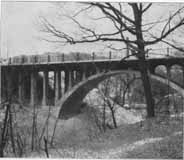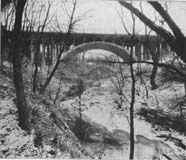 The original North High School, located at 100 West 4th Street at the corner of 4th Avenue and Dennison Avenue, had opened its doors on February 3, 1893 with eight teachers and 300 students. The student body quickly outgrew the building and an annex was constructed in 1902. That, too, became overcrowded.
The original North High School, located at 100 West 4th Street at the corner of 4th Avenue and Dennison Avenue, had opened its doors on February 3, 1893 with eight teachers and 300 students. The student body quickly outgrew the building and an annex was constructed in 1902. That, too, became overcrowded.
 After a new high school was completed, the old building became Everett Junior High School, named after the first North High School principal C. D. Everett. This first building—designed by Frank Packard and built at a cost of $14,000—is still in use. As shown in the lower photograph, the turrets and other elaborate structures have since been removed from the school. (Photo courtesy of Columbus Metropolitan Libraries)
After a new high school was completed, the old building became Everett Junior High School, named after the first North High School principal C. D. Everett. This first building—designed by Frank Packard and built at a cost of $14,000—is still in use. As shown in the lower photograph, the turrets and other elaborate structures have since been removed from the school. (Photo courtesy of Columbus Metropolitan Libraries)
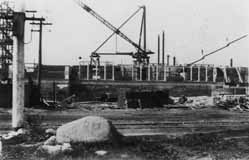
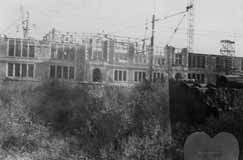
 In 1921, the Columbus Board of Education purchased 13.15 acres for $35,000 to build a new high school. The property had been owned by the American Vitrified Products Company. The land bordered on a deep ravine; the ravine was considered to be an asset for science classes, as was the proximity of the property to the streetcar tracks. Many other sites had been considered, including somewhere on the campus of Ohio State University. Discarded bricks and baked clay shards had to be removed from the old brick yard before construction of the school could begin. The new building was designed by architect Frank Packard and cost $1,000,000. Construction began in 1923 and the building opened on September 2, 1924. It graduated its first class in January of 1925. For a brief time, the new high school was named Edward Orton High School. It served as an anchor for the community; often three generations of Clintonville families attended the school. It was one of the city’s top college-preparation schools; between 90 and 95 percent of the students went on to higher education. North High School was closed in 1979 as part of the city’s desegregation plan and subsequently became an adult education center and has also served as temporary quarters for schools undergoing renovations. (Photos courtesy of Leeann Faust)
In 1921, the Columbus Board of Education purchased 13.15 acres for $35,000 to build a new high school. The property had been owned by the American Vitrified Products Company. The land bordered on a deep ravine; the ravine was considered to be an asset for science classes, as was the proximity of the property to the streetcar tracks. Many other sites had been considered, including somewhere on the campus of Ohio State University. Discarded bricks and baked clay shards had to be removed from the old brick yard before construction of the school could begin. The new building was designed by architect Frank Packard and cost $1,000,000. Construction began in 1923 and the building opened on September 2, 1924. It graduated its first class in January of 1925. For a brief time, the new high school was named Edward Orton High School. It served as an anchor for the community; often three generations of Clintonville families attended the school. It was one of the city’s top college-preparation schools; between 90 and 95 percent of the students went on to higher education. North High School was closed in 1979 as part of the city’s desegregation plan and subsequently became an adult education center and has also served as temporary quarters for schools undergoing renovations. (Photos courtesy of Leeann Faust)
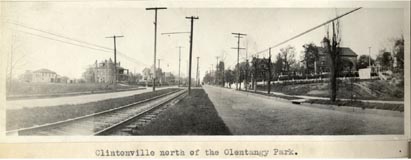
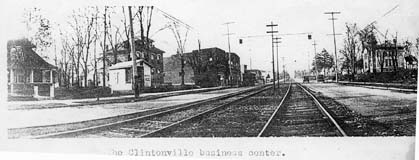
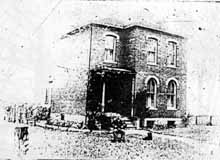 The township school located at Clinton Heights Avenue and North High Street did not, originally, have running water. Every day a child was designated to carry one bucket and dipper across High Street to the Chesnut house (see page 12 in my book, Clintonville and Beechwold) to fetch water that would be shared by the students. Legend has it that there were no lack of volunteers for water duty, as Mrs. Chesnut (or perhaps it was her daughter Fannie) always had cookies for the volunteer. This is a bad, yet significantly older, image of the Chesnut house.
The township school located at Clinton Heights Avenue and North High Street did not, originally, have running water. Every day a child was designated to carry one bucket and dipper across High Street to the Chesnut house (see page 12 in my book, Clintonville and Beechwold) to fetch water that would be shared by the students. Legend has it that there were no lack of volunteers for water duty, as Mrs. Chesnut (or perhaps it was her daughter Fannie) always had cookies for the volunteer. This is a bad, yet significantly older, image of the Chesnut house.  Overcrowded schools were a chronic problem, and the schools supplemented their brick-and-mortar ediifices with portable buildings. In response to the overcrowding of the east building, Clinton Elementary School’s west building was constructed in 1922. Both the east and west buildings have been in use for elementary and kindergarten grades since that time. (Photo courtesy of Columbus City Schools)
Overcrowded schools were a chronic problem, and the schools supplemented their brick-and-mortar ediifices with portable buildings. In response to the overcrowding of the east building, Clinton Elementary School’s west building was constructed in 1922. Both the east and west buildings have been in use for elementary and kindergarten grades since that time. (Photo courtesy of Columbus City Schools)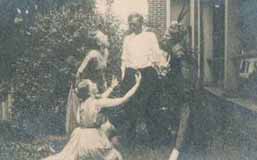

 The original North High School, located at 100 West 4th Street at the corner of 4th Avenue and Dennison Avenue, had opened its doors on February 3, 1893 with eight teachers and 300 students. The student body quickly outgrew the building and an annex was constructed in 1902. That, too, became overcrowded.
The original North High School, located at 100 West 4th Street at the corner of 4th Avenue and Dennison Avenue, had opened its doors on February 3, 1893 with eight teachers and 300 students. The student body quickly outgrew the building and an annex was constructed in 1902. That, too, became overcrowded.  After a new high school was completed, the old building became Everett Junior High School, named after the first North High School principal C. D. Everett. This first building—designed by Frank Packard and built at a cost of $14,000—is still in use. As shown in the lower photograph, the turrets and other elaborate structures have since been removed from the school. (Photo courtesy of Columbus Metropolitan Libraries)
After a new high school was completed, the old building became Everett Junior High School, named after the first North High School principal C. D. Everett. This first building—designed by Frank Packard and built at a cost of $14,000—is still in use. As shown in the lower photograph, the turrets and other elaborate structures have since been removed from the school. (Photo courtesy of Columbus Metropolitan Libraries)

 In 1921, the Columbus Board of Education purchased 13.15 acres for $35,000 to build a new high school. The property had been owned by the American Vitrified Products Company. The land bordered on a deep ravine; the ravine was considered to be an asset for science classes, as was the proximity of the property to the streetcar tracks. Many other sites had been considered, including somewhere on the campus of Ohio State University. Discarded bricks and baked clay shards had to be removed from the old brick yard before construction of the school could begin. The new building was designed by architect Frank Packard and cost $1,000,000. Construction began in 1923 and the building opened on September 2, 1924. It graduated its first class in January of 1925. For a brief time, the new high school was named Edward Orton High School. It served as an anchor for the community; often three generations of Clintonville families attended the school. It was one of the city’s top college-preparation schools; between 90 and 95 percent of the students went on to higher education. North High School was closed in 1979 as part of the city’s desegregation plan and subsequently became an adult education center and has also served as temporary quarters for schools undergoing renovations. (Photos courtesy of Leeann Faust)
In 1921, the Columbus Board of Education purchased 13.15 acres for $35,000 to build a new high school. The property had been owned by the American Vitrified Products Company. The land bordered on a deep ravine; the ravine was considered to be an asset for science classes, as was the proximity of the property to the streetcar tracks. Many other sites had been considered, including somewhere on the campus of Ohio State University. Discarded bricks and baked clay shards had to be removed from the old brick yard before construction of the school could begin. The new building was designed by architect Frank Packard and cost $1,000,000. Construction began in 1923 and the building opened on September 2, 1924. It graduated its first class in January of 1925. For a brief time, the new high school was named Edward Orton High School. It served as an anchor for the community; often three generations of Clintonville families attended the school. It was one of the city’s top college-preparation schools; between 90 and 95 percent of the students went on to higher education. North High School was closed in 1979 as part of the city’s desegregation plan and subsequently became an adult education center and has also served as temporary quarters for schools undergoing renovations. (Photos courtesy of Leeann Faust) 
